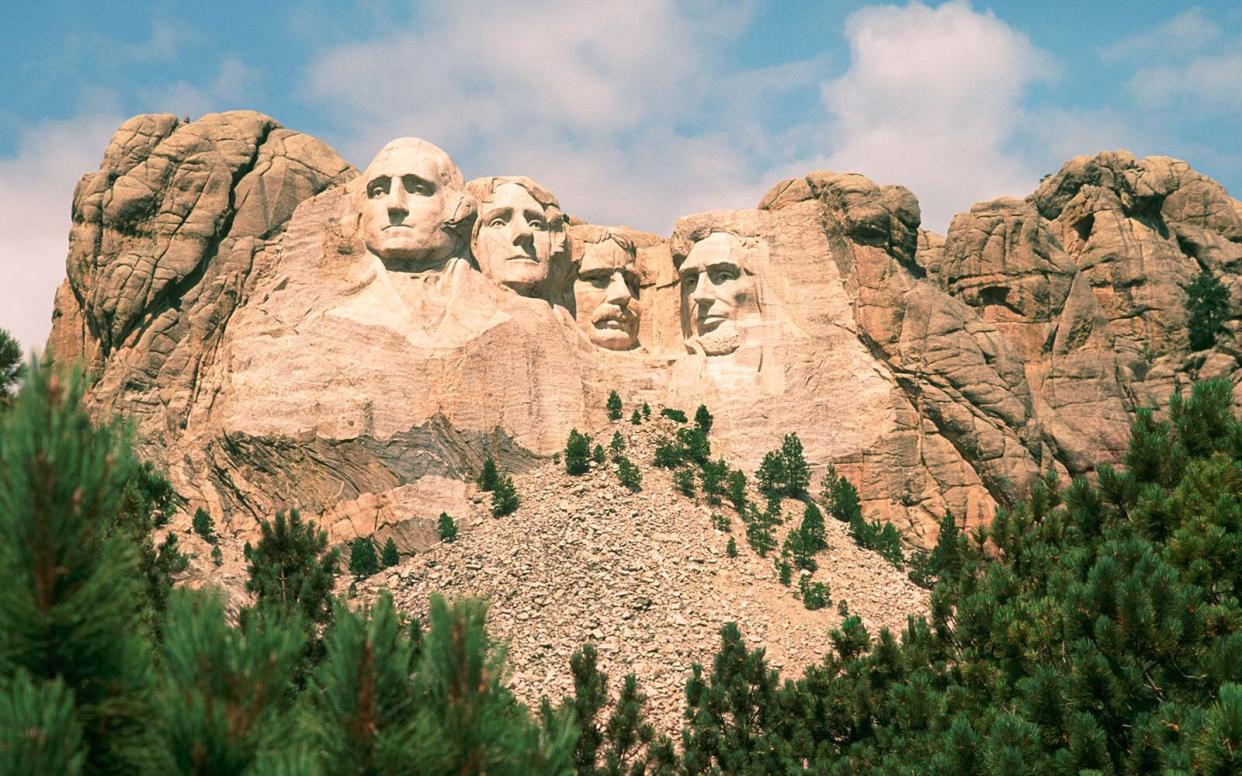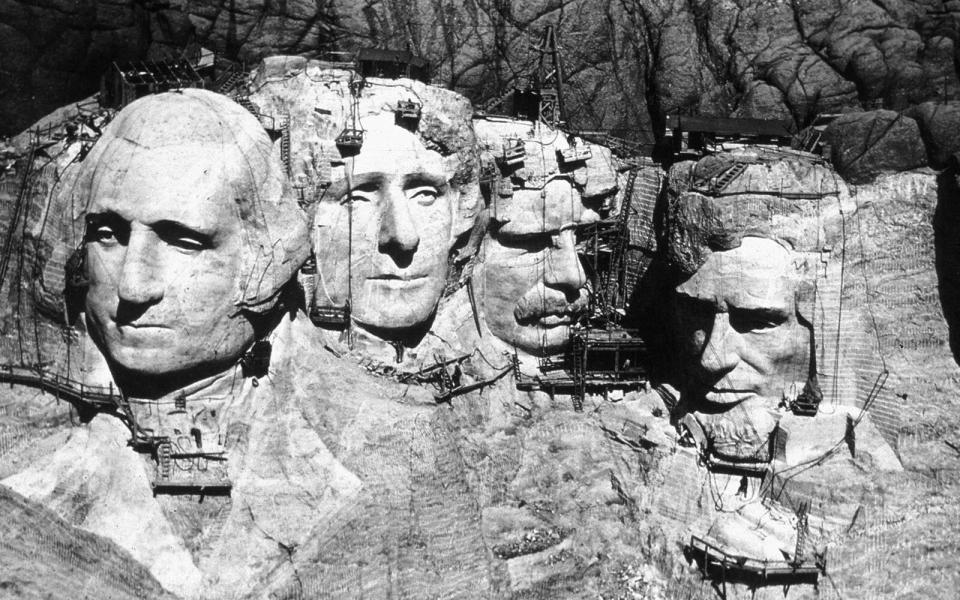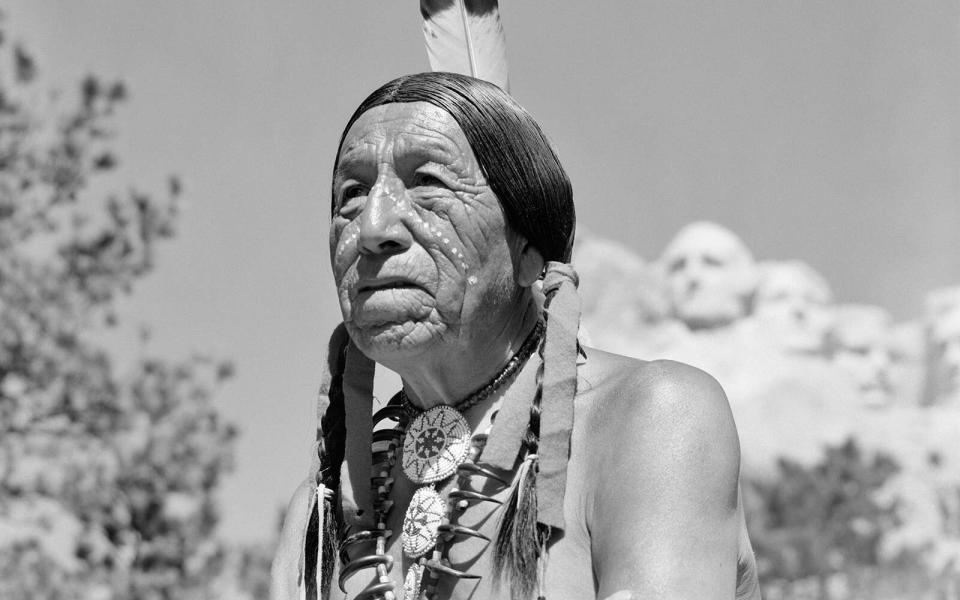Nine Secrets of Mount Rushmore

- Oops!Something went wrong.Please try again later.
- Oops!Something went wrong.Please try again later.
- Oops!Something went wrong.Please try again later.
- Oops!Something went wrong.Please try again later.
JMichl/Getty Images
Freedom, justice, hope — South Dakota's beloved national memorial, Mount Rushmore, is a testament to these deeply cherished American values. The quartet of presidential busts carved into a granite peak in the Black Hills is one of the most iconic symbols of the United States, on par with the Liberty Bell and the Statue of Liberty.
In fact, the colossal, 60-foot profiles of George Washington, Abraham Lincoln, Thomas Jefferson, and Theodore Roosevelt are so instantly recognizable, they've been spoofed in commercials, used as film backdrops (including Alfred Hitchcock's "North by Northwest"), and reproduced in all sizes and forms, including a giant construction at Legoland. But for all of Mount Rushmore's widespread fame (and over 2 million annual visitors), it's also a place with a deep history and plenty of little-known facts.
The original plan featured a different set of figures
It's hard to imagine Mount Rushmore without the commanding presence of these particular presidents. But believe it or not, Plan A was to spotlight rugged regional heroes such as Lewis and Clark, Buffalo Bill Cody, and the Oglala Lakota leader, Red Cloud. The figures would be carved into the granite pillars known as The Needles. This, essentially, would have made the work similar to a set of totem poles.
Calvin Coolidge was courted for federal funds
When Mount Rushmore was conceived in the late 1920s, President Calvin Coolidge chose to summer in the Black Hills. Locals came up with wildly creative ways to make the leader's stay comfortable, including gifts like a 10-gallon hat. Once, a plane air-dropped a wreath of flowers at his lodge, and even a creek was stocked with fattened trout from a hatchery so the president could have an easy time fishing.

MPI/Getty Images
Theodore Roosevelt isn’t wearing glasses
Only the pince-nez (and neither the lenses nor the ear pieces) was carved onto President Roosevelt's face along with ridges on the upper cheeks. From far away, the commander-in-chief looks as if he's donning a pair of spectacles. It's an impressive optical illusion and sculptural stunt.
There’s a hidden chamber behind Lincoln’s head
To accompany the faces, Rushmore's sculptor, Gutzon Borglum, had ambitious visions of a repository with an entrance crowned by a bronze eagle, accessible by a grand staircase. Interiors were to be adorned with friezes, vaulted ceilings, busts, and bronze-and-glass cabinets that housed artifacts central to American democracy. The construction only got so far — a tunnel was blasted into the canyon — before it was abandoned. Though the unfinished Hall of Records remains off-limits to visitors, it's the bearer of a titanium vault with porcelain panels outlining milestones in U.S. history.
Attempts have been made to add a fifth face
Women's rights activist Rose Arnold Powell led an indefatigable crusade to get Susan B. Anthony's visage on the mountain (she continued the campaign even after suffering a terrible car accident). Meanwhile, conservatives spearheaded the "Reagan on Rushmore" or "Ron on the Rocks" movement to memorialize the 40th president's legacy. There have even been efforts to add Elvis Presley's slicked-back likeness to the Black Hills.
The best views are from the President’s Trail
Follow the crowds, and you'll end up at the Grand View Terrace, just beyond the Avenue of the Flags. True, the head-on views are spectacular and unobstructed. But you can do better. Walk the often-bypassed loop around the base of the mountain. Climbing up the steps through ponderosa pines, you can get a closer view of the faces at various twists and turns (and maybe catch a glimpse of a Rocky Mountain goat or a mule deer, too).

H. Armstrong Roberts/ClassicStock/Getty Images
It’s been the host of protests
Among the ice cream stands, souvenir shops, and year-round flurry of snap-happy tourists, it's hard to picture Mount Rushmore as anything but a destination for easygoing recreation. But it's also been the site of continued controversy. The area was named Sioux territory by the Fort Laramie Treaty of 1868, and for Native American protesters — particularly active in the 1970s — Mount Rushmore is a painful reminder of broken treaties and a history of mistreatment. This sentiment is only worsened by the men represented on the monument.
The monument isn't finished
If there's something raw and rugged about Mount Rushmore, it's because it's far from a finished masterpiece. Save for a final brush-up by Borglum's son, Lincoln, construction halted after the original sculptor's death. The model was meant to depict the heads-of-state down to the waist, but today you can barely make out Washington's coat collar, and Lincoln's ear, shoulder, and a fourth knuckle were never chiseled to completion.
Google Maps sometimes gets the address wrong
If you're using Google Maps to locate this national landmark, be very, very specific. Apparently, general searches for Mount Rushmore often send travelers astray. If you find yourself at a Methodist campground called Storm Mountain Center, you're about 12 miles away from the memorial.

